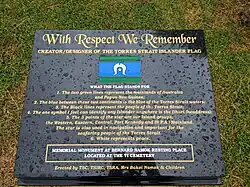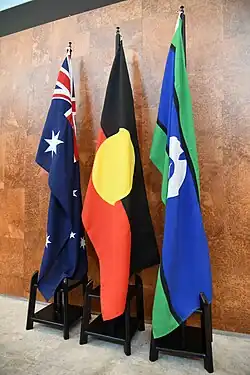Torres Strait Islander flag
 | |
| Proportion | 2:3 or 1:2 (displayed above) |
|---|---|
| Adopted | 14 July 1995 |
| Designed by | Bernard Namok |
The Torres Strait Islander flag is the official flag of the Torres Strait Islanders, an Indigenous people of Australia. It was designed in 1992 by Bernard Namok, who won a local competition held by the Islands Coordinating Council.
It was formally presented to the Torres Strait Islander people on 29 May 1992 at the Torres Strait Cultural Festival. The next month, the flag was recognised by the Aboriginal and Torres Strait Islander Commission in June 1992. It was granted official status in 1995 under the Flags Act 1953, alongside the Australian Aboriginal flag.[1]
Status
On 14 July 1995, the Keating government advised the proclamation of the Torres Strait Islander flag as "the flag of the Torres Strait Islander people of Australia", under section five of the Flags Act 1953. The proclamation noted that the flag was "recognised as the flag of the Torres Strait Islander people of Australia and a flag of significance to the Australian nation generally".[2]
An "administrative oversight" caused the 1995 proclamation not to be lodged to continue in force indefinitely; hence, it automatically expired on 1 January 2008. It was almost identically replaced, on 25 January 2008, with retroactive effect as from 1 January.[3]
Although Namok had died in 1993, the Torres Strait Islander flag is still subject to copyright under the Copyright Act 1968 (Cth). The copyright was administered by the Island Coordinating Council until 2008, when that body was superseded by the Torres Strait Island Regional Council. It is willing to permit reproductions of the flag that are accurate and acknowledge Namok as the designer.[4]
Colours
The official colours of the flag of the Torres Strait Islanders are as follows:
| Scheme | Green | Blue | Black | White |
|---|---|---|---|---|
| Pantone[5][6] | 3288 C or 342 C | 301 C or 280 C | Black C | Safe |
| RGB | 0–153–102
(#009966) |
0–0–153
(#000099) |
0–0–0
(#000000) |
255–255–255
(#FFFFFF) |
| CMYK[5] | 100%–0%–80%–40% | 100%–70%–0%–0% | 0%–0%–0%–100% | 0%–0%–0%–0% |
Symbolic meaning

Bernard Namok gave each of flag's elements a symbolic meaning:[7][6][8]
- Top green stripe – Migi Daudai (Papua New Guinea)
- Bottom green stripe – Koey Daudai (mainland Australia)
- Blue stripe – Malu (the sea of the Torres Strait)
- White dhari – Torres Strait Islander culture
- Black stripes – Torres Strait Islander people
- White star – Ancestors, peace, Christianity and a symbol of navigation. The star points also each represent the island groups of the Torres Strait:
Public display

Over time, the Torres Strait Islander Flag, alongside the Aboriginal Flag, have been installed permanently in many government institutions.[9][10]
Following the 2022 Australian federal election on 21 May 2022, the incoming Anthony Albanese-led Labor government started displaying the Aboriginal flag and the Torres Strait Islander flag alongside the national flag at ministerial press conferences.[11] Upon the opening of the new Parliament, both flags began to be displayed in the House of Representatives and Senate chambers.[12]
Local flags
Murray Island
-
.svg.png) Flag of Murray Island
Flag of Murray Island
The flag of Murray Island, located in the eastern section of the Torres Strait, consists of three vertical stripes: red ochre, white, and black representing the Torres Strait Creole. In the canton, there is a depiction of a beach hibiscus symbolizing peace and authority, placed on a white disc surrounded by eight six-pointed mullet stars representing the 8 Meriam tribes. The flag was designed by local artist Andrew Passi senior.[13]
Saibai Island
-
 Flag of Saibai Island
Flag of Saibai Island
The flag of Saibai Island, situated four kilometres from the nation of Papua New Guinea. It consists of a green triangle symbolizing the land and a dark blue field representing the sea. Within the green triangle there is a yellow leaf, symbolizing peace. Additionally, an eight-pointed star represents Australia. The flag was chosen by members of the Northern Peninsula Area Regional Council.[14]
See also
References
- ^ "Torres Strait Islander flag". AIATSIS. Retrieved 13 August 2025.
- ^ "Flags Act 1953 Proclamation". Commonwealth of Australia Gazette (S258). 14 July 1995. Archived from the original on 19 January 2024. Retrieved 19 January 2024.
- ^ Proclamation under the Flags Act 1953 (Torres Strait Islander Flag)
- ^ "Torres Strait Islander flag". Torres Strait Island Regional Council. Archived from the original on 13 July 2018. Retrieved 13 July 2018.
- ^ a b c Australia. (2002). Style manual for authors, editors and printers. Snooks & Co. (6th ed.). Canberra: John Wiley & Sons Australia. p. 300. ISBN 9780701636487. OCLC 49316140.
- ^ a b "Australian flags". Australian Government: Department of the Prime Minister and Cabinet. Archived from the original on 1 December 2017. Retrieved 13 August 2025.
- ^ Namok Jnr, Bernard; Mayo, Thomas (2024). Our Flag, Our Story: The Torres Strait Islander Flag. Illustrations by Tori-Jay Mordey. Broome: Magabala Books. ISBN 978-1-922613-50-9.
- ^ Shnukal, Anna (2001). "Torres Strait Islanders" (PDF). In Brandle, Maximilian (ed.). Multicultural Queensland 2001: 100 years, 100 communities, a century of contributions. pp. 22–23. ISBN 0724228004.
- ^ "Australian Aboriginal flag". City of Adelaide. 13 May 2019. Archived from the original on 19 July 2019. Retrieved 4 June 2022.
- ^ Opie, Rebecca (27 May 2022). "Aboriginal and Torres Strait Islander flags permanently fly at Government House". ABC News. Australian Broadcasting Corporation. Archived from the original on 4 June 2022. Retrieved 4 June 2022.
- ^ Knowles, Rachael (23 May 2022). "Aboriginal and Torres Strait Islander Flags flank Prime Minister's debut". NITV. Archived from the original on 4 June 2022. Retrieved 4 June 2022.
- ^ Mahony, Jack (28 July 2022). "Senate President Sue Lines no longer wants the Lord's Prayer read before each sitting day in Parliament". Sky News Australia. Archived from the original on 28 July 2022. Retrieved 28 July 2022.
- ^ "Mer Island (Murray Island) Flag Circa 1980's". Archived from the original on 3 August 2023. Retrieved 3 August 2023.
- ^ "Saibai Island Flag 2001". Archived from the original on 3 August 2023. Retrieved 3 August 2023.
Further reading
- Mounter, Brendan (29 May 2021). "Torres Strait Islanders fly the flag for cultural identity on banner day for community". ABC News.
- Torres Strait Islander flag (AIATSIS)
- "Torres Strait Flag". Torres Strait Regional Authority. 22 August 2023.
External links
- Carry the Flag (2017), documentary on the life of Bernard Namok